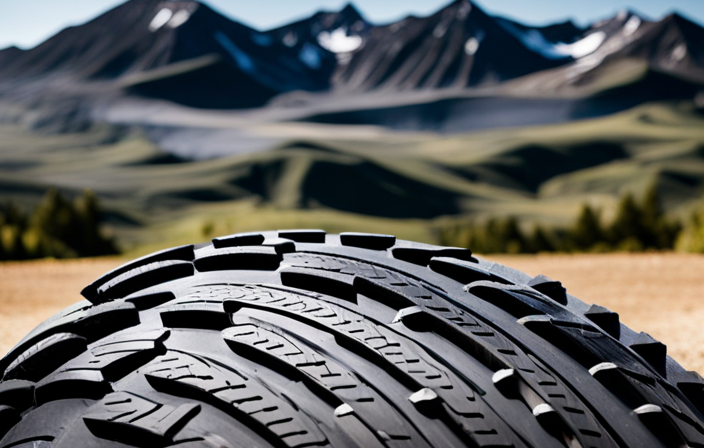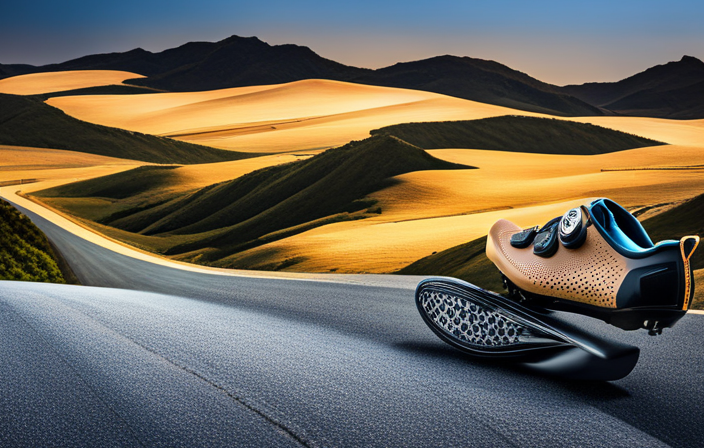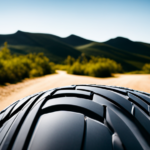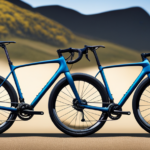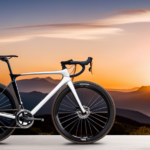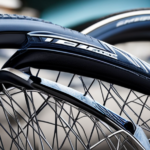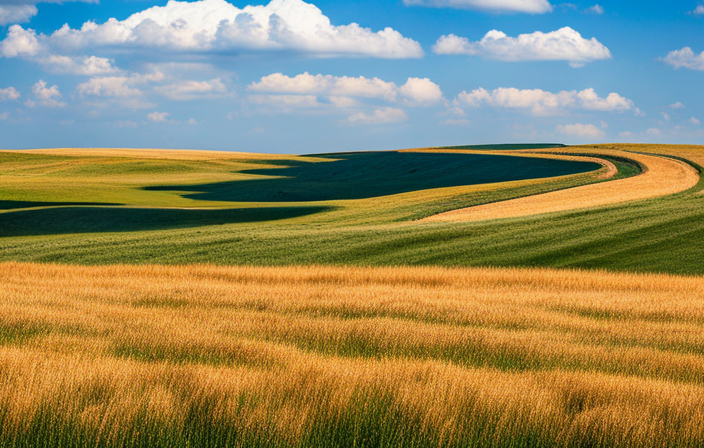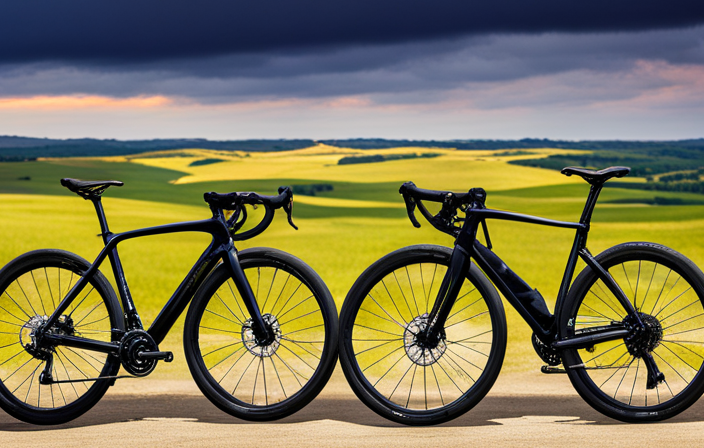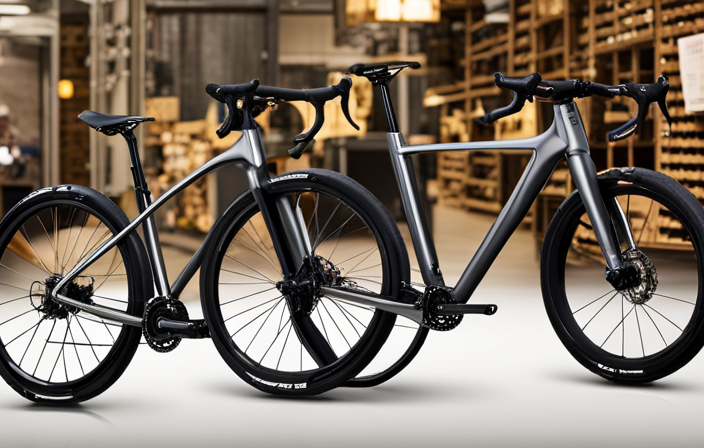Imagine this: you’re embarking on an exciting journey, steering through the challenging landscape of gravel roads. However, there’s a hitch – your bike tires are having a hard time keeping pace! Selecting the appropriate bike tire size for gravel roads is essential for a seamless and delightful cycling experience.
In this article, I’ll guide you through understanding the terrain, factors to consider when choosing tires, pros and cons of wide and narrow options, specialized gravel tires, expert recommendations, maintenance tips, and exploring accessories.
Get ready to conquer those gravel trails with confidence!
Key Takeaways
- Wider tires provide increased stability and traction on various terrains, making them ideal for gravel roads.
- Narrower tires offer reduced rolling resistance for increased speed and efficiency, but they may have less grip on loose surfaces and decreased traction on rough terrain.
- Consider the optimal tire width for comfort and performance, taking into account factors such as tread patterns and terrain conditions.
- Specialized gravel tires are designed specifically for gravel riding and offer enhanced performance on gravel roads, so it is recommended to use them and seek professional guidance for the best options.
Understanding the Terrain of Gravel Roads
To better understand the terrain of gravel roads, you’ll need to consider the size of bike tire that works best. Understanding gravel road conditions is essential in determining the appropriate tire size for optimal performance. Gravel roads are characterized by loose rocks, uneven surfaces, and varying levels of traction. These factors can greatly impact your ride experience and overall safety.
When it comes to choosing the right bike tire for gravel roads, one crucial aspect to consider is the tread pattern. The tread pattern plays a significant role in how well your tires grip the surface and handle various terrains. Tires with larger knobs or lugs tend to perform better on loose gravel as they provide more traction and stability. On the other hand, tires with smaller knobs or a smoother tread pattern may be more suitable for compacted or hard-packed gravel surfaces.
By understanding these gravel road conditions and considering the impact of tire tread patterns on performance, you can make an informed decision about what size bike tire will work best for your needs. Factors such as tire width, sidewall protection, and tubeless compatibility should also be taken into account when selecting tires for riding on gravel roads.
Transitioning into the subsequent section about ‘factors to consider when choosing bike tires for gravel,’ it’s important to keep these considerations in mind to ensure a safe and enjoyable ride experience without compromising performance.
Factors to Consider When Choosing Bike Tires for Gravel
When choosing tires for riding on gravel, you should consider various factors. Understanding tire construction is crucial in determining the right tire for your needs. Gravel roads can be challenging due to loose surfaces and unpredictable terrain, so having a tire with appropriate tread and durability is essential. Additionally, the impact of tire pressure on performance should not be overlooked.
To help you make an informed decision, I have created a table below that highlights the key factors to consider when choosing bike tires for gravel:
| Factors to Consider | Explanation |
|---|---|
| Tread Pattern | A more aggressive tread pattern provides better traction on loose surfaces. |
| Tire Width | Wider tires offer increased stability and comfort while sacrificing some speed. |
| Sidewall Protection | Reinforced sidewalls protect against punctures from sharp rocks or debris. |
| Tubeless Ready | Tubeless tires allow for lower tire pressures without risking pinch flats. |
| Rolling Resistance | Tires with lower rolling resistance provide faster speeds on smoother sections of gravel roads. |
Understanding these factors will help you select the best tire for your gravel riding adventures. In the next section, we will explore different tire width options for gravel riding, which further influences performance and comfort.
Without delay, let’s dive into the world of tire width options for gravel riding!
Tire Width Options for Gravel Riding
One important factor to consider for a smooth gravel riding experience is the width of your tires. When it comes to tire width options for gravel riding, there are a few factors to keep in mind.
The first is that wider tires generally provide better stability and traction on loose or uneven surfaces. This is because they have a larger contact patch with the ground, allowing for increased grip and control. Additionally, wider tires can also absorb more bumps and vibrations, resulting in a more comfortable ride.
On the other hand, narrower tires tend to be faster on hard-packed gravel roads. They have less rolling resistance, which means you can maintain higher speeds with less effort. However, they may not perform as well on rougher terrains or when faced with loose gravel.
When considering tire width options for gravel riding, it’s also important to think about tread patterns. Depending on the type of terrain you’ll be riding on, you may want to choose a tire with more aggressive tread patterns for added traction in muddy or sandy conditions.
In conclusion, choosing the right tire width options and tread patterns can greatly enhance your gravel riding experience by providing optimal stability and control. Now let’s delve into the pros and cons of wide tires without further ado…
The Pros and Cons of Wide Tires
If you want an optimal riding experience, wider tires can provide better stability and control on various terrains. When it comes to gravel riding, tire width plays a crucial role in determining how well your bike handles the rough and unpredictable surfaces. Wide tires, typically ranging from 40mm to 50mm, offer several advantages for gravel riding.
Firstly, wider tires provide increased traction on loose surfaces like gravel. The larger contact patch allows for better grip and reduces the chances of sliding or losing control while navigating through tricky sections. Additionally, wide tires have lower rolling resistance due to their larger volume and lower pressure requirements. This means that you can maintain higher speeds with less effort as compared to narrower options.
However, there are also some disadvantages to consider when choosing wider tires for gravel riding. One drawback is increased weight, which can make the bike feel sluggish and affect acceleration. Moreover, wide tires may not fit all frames or forks due to clearance issues.
Transitioning into the next section about ‘the pros and cons of narrow tires,’ it’s important to note that while wide tires have their advantages for gravel riding, narrow tires also have their own set of benefits and drawbacks.
The Pros and Cons of Narrow Tires
For a more agile and responsive ride, you’ll want to consider narrower tires for your gravel adventures. While wide tires offer advantages in terms of stability and traction, narrow tires have their own set of benefits.
One advantage of narrow tires is their reduced rolling resistance. With less surface area in contact with the ground, they require less effort to move forward, resulting in increased speed and efficiency on gravel roads. Additionally, narrow tires provide better maneuverability due to their smaller profile. They allow for quicker turns and easier navigation through tight corners or obstacles.
However, it’s important to note that narrow tires may not perform as well as wide ones in certain conditions. Their reduced width means they have less grip on loose surfaces like gravel or mud compared to wider options. This can result in decreased traction and control, especially when riding over rough terrain or encountering sudden changes in road conditions.
In finding the right balance between narrow and wide tires, optimal tire width is key. It depends on various factors such as rider preference, terrain type, and intended use. Considerations should include the level of comfort desired during rides as wider tires tend to provide a smoother experience over rough surfaces.
To explore the optimal tire width for gravel riding further, let’s delve into the benefits of finding the right balance between agility and stability on varied terrains without sacrificing performance or comfort.
Finding the Right Balance: Optimal Tire Width for Gravel
To achieve the ideal balance between agility and stability on various terrains, it’s crucial to consider the optimal width of your tires for gravel riding. When it comes to riding on gravel roads, tire width plays a significant role in determining traction and stability.
Choosing the right tire tread pattern for gravel is essential, but equally important is finding the right tire width. The impact of tire width on traction and stability cannot be overstated. A wider tire provides more contact with the ground, which translates into better grip and improved control. On loose or uneven surfaces like gravel roads, this can make a world of difference in terms of confidence and handling. However, it’s important to find the right balance because an excessively wide tire can compromise agility and responsiveness.
When considering tire width for gravel riding, there are a few factors to keep in mind. The first is your body weight and riding style. Heavier riders may benefit from wider tires to distribute their weight more evenly and prevent sinking into soft surfaces. Additionally, your bike frame clearance should also be taken into account as some frames have limitations on how wide of a tire they can accommodate.
In conclusion, finding the optimal tire width for gravel riding requires striking a balance between traction/stability and agility/responsiveness. In the next section about tread patterns for gravel riding…
Tread Patterns for Gravel Riding
The tread pattern on your tires can greatly impact your performance while riding on gravel. When it comes to choosing the right tire tread for gravel riding, there are a few options to consider. Different tire tread types offer varying levels of traction and control, allowing you to navigate through loose gravel with ease.
There are three common types of tire treads that work well for gravel riding: knobby, file, and mixed. Knobby tires have large, aggressive knobs that provide excellent grip on loose surfaces. File tires have a smoother center section with smaller knobs on the sides, offering a balance between rolling resistance and traction. Mixed tires combine elements of both knobby and file treads, providing versatility across different terrain conditions.
To help you visualize the differences between these tread patterns, here’s a table showcasing some popular tire brands for gravel riding:
| Tire Brand | Tread Pattern |
|---|---|
| WTB | Knobby |
| Panaracer | File |
| Schwalbe | Mixed |
| Maxxis | Mixed |
Choosing the right tire brand is essential for optimal performance on gravel roads. Each brand offers its own unique features and strengths when it comes to tire design.
Now that we’ve covered tire tread types and best brands for gravel riding, let’s delve into the next topic: tubeless vs. tubed tires – which is better for gravel?
Tubeless vs. Tubed Tires: Which is Better for Gravel?
When it comes to tire choice for gravel riding, you might be wondering whether tubeless or tubed tires are better. Both options have their advantages and disadvantages that are worth considering before making a decision.
Advantages of Tubeless Tires:
- Reduced risk of flats: Tubeless tires are less likely to puncture compared to tubed tires because they don’t have an inner tube that can be pierced by sharp objects.
- Lower rolling resistance: The absence of a tube reduces friction, resulting in faster speeds and improved efficiency on gravel roads.
- Ability to run lower pressures: Tubeless tires allow you to lower the tire pressure for better traction and comfort without worrying about pinch flats caused by too low pressure with tubes.
- Self-sealing properties: Small punctures in tubeless tires can seal themselves thanks to the sealant inside, minimizing the need for immediate repairs.
- Potential weight savings: Tubeless setups tend to be lighter than tubed ones, contributing to a more nimble ride on gravel.
Disadvantages of Tubeless Tires:
- Initial setup complexity: Mounting tubeless tires can be more challenging compared to traditional tubed ones, requiring specific rims and sealant application.
- Sealant maintenance: The sealant inside tubeless tires needs occasional replenishing or replacing as it dries out over time.
- Costly conversion: Switching from tubed to tubeless setup may require new rims and other components, which can add up in terms of expenses.
Transitioning into the subsequent section about ‘tire pressure: finding the sweet spot for gravel riding’, it’s important to consider not only the type of tire but also its pressure for optimal performance on gravel roads.
Tire Pressure: Finding the Sweet Spot for Gravel Riding
Finding the sweet spot for tire pressure on your gravel rides can greatly impact your overall riding experience. When it comes to finding the ideal tire pressure for different gravel conditions, there are a few factors to consider.
The first is comfort. Running lower tire pressure allows for more cushioning and absorbs the vibrations from rough gravel roads, providing a smoother ride. However, going too low can increase the risk of pinch flats or bottoming out on sharp rocks or roots.
On the other hand, higher tire pressure offers better rolling efficiency and reduces the risk of pinch flats. It also provides improved traction by allowing the tires to conform better to uneven surfaces, increasing grip. However, too high of a pressure can result in a harsher ride and less control over loose surfaces.
To find the perfect balance, start with a mid-range tire pressure and adjust accordingly based on your weight and preferences. Experimenting with different pressures will help you determine what works best for you in various gravel conditions.
Transition: Now that we’ve covered finding the ideal tire pressure for gravel riding, let’s move on to discussing puncture protection: essential features for gravel tires.
Puncture Protection: Essential Features for Gravel Tires
One important consideration for gravel riders is ensuring their tires have essential features for puncture protection. When riding on gravel roads, there is a higher risk of encountering sharp rocks, thorns, and other debris that can easily puncture a tire. That’s why it’s crucial to invest in tires with top puncture protection technologies.
Puncture protection is of utmost importance because it helps prevent flats and ensures a smooth ride. There are various technologies available in the market that provide excellent puncture resistance. Some popular options include Kevlar belts, which are lightweight yet incredibly strong, and reinforced sidewalls that offer extra durability against cuts and abrasion.
Another technology worth considering is tubeless setup. With this system, sealant is added inside the tire to automatically seal small punctures as they occur. This not only provides added protection but also allows for lower tire pressures, enhancing comfort and traction on rough gravel surfaces.
Incorporating these top puncture protection technologies into your gravel tires will give you peace of mind while riding. It minimizes the chances of getting stranded on a remote trail with a flat tire and allows you to fully enjoy your off-road adventures.
When it comes to choosing long-lasting tires for gravel, durability and longevity become paramount considerations.
[Transition Sentence: Now let’s explore how to select tires that will go the distance.]Durability and Longevity: Choosing Long-Lasting Tires for Gravel
To ensure your gravel riding experience is long-lasting, it’s important to consider the durability and longevity of the tires you choose. When it comes to gravel roads, longevity becomes a crucial factor as these terrains can be harsh on tires. Finding a balance between longevity and performance is key.
One way to ensure durability is by choosing tires with tread patterns specifically designed for gravel. These patterns are usually more aggressive than those found on road or mountain bike tires, providing better traction and grip on loose surfaces. Additionally, they help in dispersing water and mud, reducing the chances of slipping or losing control.
To help you make an informed decision, I have created a table that compares some popular tire options based on their durability and longevity:
| Tire Model | Durability | Longevity |
|---|---|---|
| Model 1 | High | Moderate |
| Model 2 | Moderate | High |
| Model 3 | Low | High |
| Model 4 | High | High |
Keep in mind that the right tire choice depends on your specific needs and riding style. It’s essential to find the right balance between durability and performance based on your preferences.
Now let’s move onto discussing whether specialized gravel tires are worth the investment without compromising performance.
Specialized Gravel Tires: Are They Worth the Investment?
Specialized gravel tires may be a worthy investment for riders looking to maximize their performance on diverse terrain. When considering investing in specialized gravel tires, there are a few key factors to keep in mind:
-
Tread Pattern: Different brands and models of specialized gravel tires offer various tread patterns designed specifically for off-road use. It’s important to consider the type of terrain you’ll be riding on and choose a tire with a tread pattern that suits your needs.
-
Width: The width of the tire can greatly impact your ride experience on gravel roads. Wider tires provide more stability and traction, especially when encountering loose or uneven surfaces. However, it’s essential to ensure that the tire width is compatible with your bike frame.
-
Puncture Protection: Gravel roads often present sharp rocks and debris that can cause punctures. Specialized gravel tires typically come with enhanced puncture protection features like reinforced casing or additional layers to minimize the risk of flats.
-
Rolling Resistance: While specialized gravel tires offer superior grip and durability, it’s crucial to balance these features with rolling resistance for optimal performance on both pavement and gravel roads.
Considering these factors will help you make an informed decision when comparing different brands and models of specialized gravel tires before making an investment. Expert recommendations for gravel tires will further guide you in finding the perfect tire for your adventures off-road without compromising on performance or safety.
Expert Recommendations for Gravel Tires
When it comes to choosing the perfect gravel tire, experts recommend considering factors such as tread pattern, width, puncture protection, and rolling resistance. The right tire can greatly enhance your riding experience on various terrain types commonly found on gravel roads.
One important aspect to consider is the tread pattern. Gravel tires typically have a more aggressive tread compared to road tires, with larger knobs or lugs that provide better traction on loose surfaces.
Another crucial factor is the width of the tire. Wider tires offer increased stability and comfort, especially when encountering rougher sections of gravel roads.
In terms of puncture protection, many manufacturers incorporate additional layers or materials into the tire construction to prevent flats caused by sharp objects commonly found on gravel paths.
Lastly, rolling resistance should be taken into account as well since it affects how easily you can pedal and maintain speed on different surfaces.
By taking these factors into consideration, you can find the ideal gravel tire for your needs and enjoy a smoother ride on any type of terrain.
Now that you have chosen the perfect gravel tire for your bike, it’s essential to know how to properly maintain and care for them in order to maximize their lifespan and performance.
Maintenance and Care Tips for Gravel Tires
Make sure you regularly inspect and clean your gravel tires to ensure optimal performance and longevity. Maintenance tips for your gravel tires are essential to keep them in the best shape possible.
Firstly, check your tire pressure before each ride as it can greatly affect traction and handling on gravel roads. Invest in a good quality pressure gauge to accurately measure the PSI. Additionally, inspect the tread pattern regularly to ensure it hasn’t worn down too much. Gravel riding can be tough on tires, so it’s important to replace them when necessary.
Tire care goes beyond just checking the pressure and tread. It’s also important to clean your tires after each ride, especially if you encountered muddy or sandy conditions. Use a mild soap and water solution along with a soft brush or sponge to gently scrub away any dirt or debris that may have accumulated on the tire surface. This will not only keep your tires looking nice but also help maintain their grip on the road.
As you explore gravel tire accessories and upgrades, remember that proper maintenance is key to getting the most out of your equipment. By following these maintenance tips and taking good care of your tires, you’ll be able to enjoy many more miles of smooth riding on those gravel roads without any worries about tire performance.
Exploring Gravel Tire Accessories and Upgrades
To enhance your gravel riding experience, consider exploring various accessories and upgrades available for your tires. Here are five options that can make a significant difference:
-
Tubeless Conversion Kit: Switching to tubeless tires can provide numerous benefits. It allows you to run lower tire pressure, enhancing traction and comfort on rough terrain. Additionally, tubeless tires reduce the likelihood of punctures, as there is no inner tube to be pinched or punctured.
-
Tire Inserts: Adding tire inserts can further improve the performance of your gravel tires. These foam or rubber inserts sit inside the tire and help prevent pinch flats while also providing additional sidewall support.
-
Tire Sealant: Using a high-quality sealant in your tubeless setup is essential. It helps seal small punctures on the go, preventing air loss and allowing you to continue riding without interruption.
-
Lightweight Casing: Upgrading to a lighter casing can significantly reduce rolling resistance and increase overall speed. Look for durable yet lightweight options specifically designed for gravel riding.
-
Tire Pressure Gauge: Accurate tire pressure is crucial for optimal performance on gravel roads. Investing in a reliable pressure gauge will allow you to easily monitor and adjust tire pressure according to the conditions you’re riding in.
By considering these accessories and upgrades, you can maximize the potential of your gravel tires, ensuring a smoother ride with improved traction, durability, and convenience.
Frequently Asked Questions
Can I use my regular road bike tires for gravel riding?
Yes, you can use your regular road bike tires for gravel racing. However, it is important to consider the terrain and conditions of the specific gravel road. Road bike tires are typically narrower and have less traction than tires specifically designed for gravel riding.
Using tubeless tires for gravel riding has several advantages, including improved puncture resistance and the ability to run lower tire pressures for better grip and comfort on rough surfaces.
Are wider tires always better for gravel riding?
Narrower tires can be suitable for gravel riding, but it’s important to find the right balance. Think of it like walking on a tightrope; too narrow and you risk losing stability, but too wide and you sacrifice speed.
Tire tread pattern also plays a role in performance. A more aggressive tread can provide better traction on loose surfaces, while a smoother tread is ideal for packed gravel roads.
It’s all about finding the sweet spot that suits your riding style and terrain.
Can I use tubeless tires on my gravel bike?
Yes, tubeless tires can be used on gravel bikes and they offer several advantages.
Firstly, tubeless tires provide a smoother ride by allowing lower tire pressures, which improves traction and comfort on rough gravel surfaces.
Additionally, they reduce the risk of punctures since there is no inner tube to pinch or get punctured.
For gravel riding, it is recommended to run tubeless tires at lower pressures between 25-35 psi to maximize grip and control on uneven terrain.
How often should I check the tire pressure on my gravel bike?
Checking the tire pressure on my gravel bike is like tuning an instrument before a performance. It ensures optimal grip and control, giving me the confidence to conquer any terrain. Regularly checking tire pressure is essential for a smooth ride.
As for cleaning, it depends on how often you ride in muddy or dusty conditions. Aim to clean your gravel bike thoroughly every 2-4 weeks to maintain its performance.
Experiment with different tire pressures to find what works best for varying gravel conditions.
What are some essential accessories or upgrades for gravel tires?
When it comes to essential accessories and tire upgrades for gravel tires, there are a few options that can greatly improve your riding experience.
One essential accessory is a set of tubeless valves and sealant, which helps prevent flats on rough terrain.
Additionally, upgrading to wider and knobbier tires can provide better traction and stability on gravel roads.
Finally, investing in a quality tire pressure gauge allows you to easily monitor and adjust your tire pressure for optimal performance.
Conclusion
After exploring the various factors to consider when choosing bike tires for gravel roads, it is clear that the size of the tire plays a crucial role in determining performance.
Wide tires offer enhanced stability and traction, making them ideal for rough terrains. However, narrow tires provide increased speed and maneuverability on smoother surfaces.
Ultimately, the decision comes down to personal preference and the specific conditions of your gravel rides.
So, whether you opt for wide or narrow tires, remember to maintain them regularly and consider investing in specialized gravel tires for an even better riding experience.
